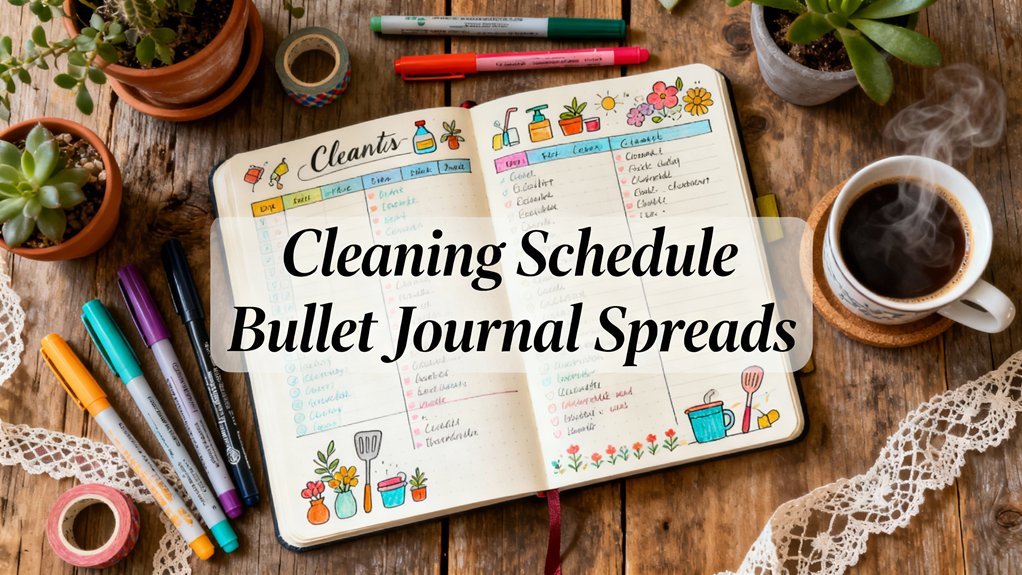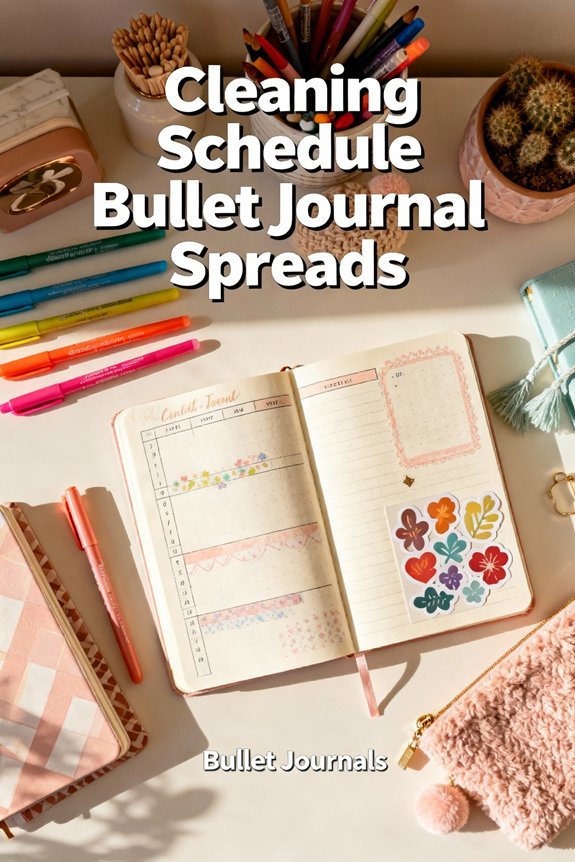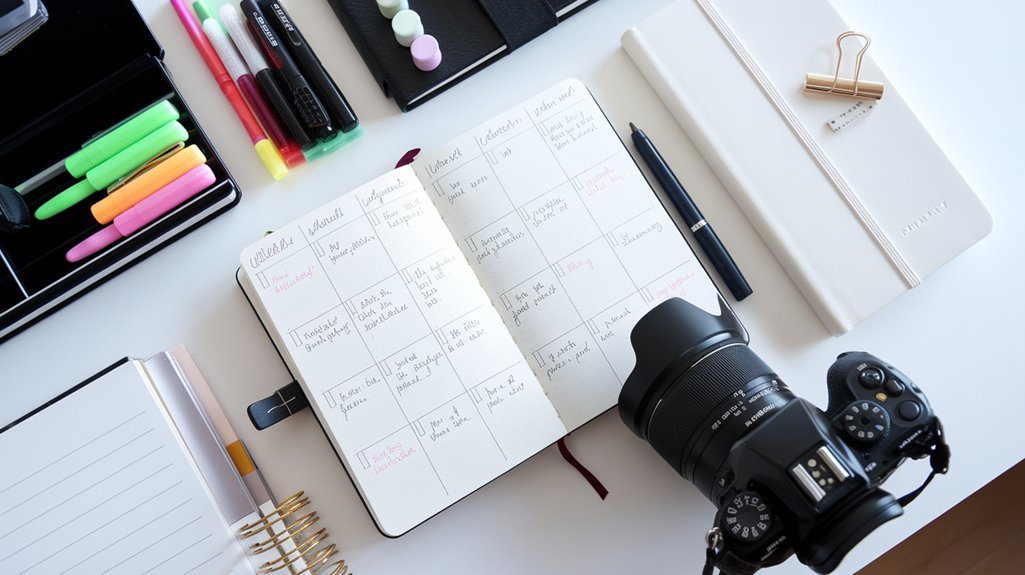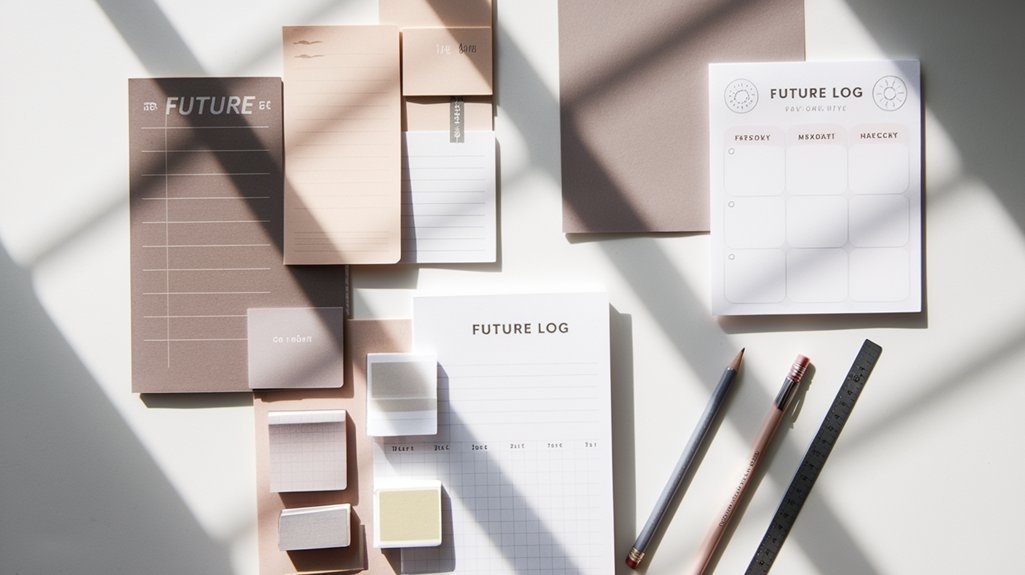You'll create effective cleaning schedule bullet journal spreads by starting with a dot grid notebook and organizing tasks into daily, weekly, and monthly layouts. Use color-coding systems to distinguish cleaning zones—blue for bathrooms, yellow for kitchens, green for outdoor spaces—which research shows reduces task-switching time by 30%. Implement habit trackers with checkbox grids to visualize completion patterns and maintain accountability. Choose between minimalist five-minute setups or decorative designs that boost completion rates by 23%. The following sections reveal specific layout frameworks and seasonal protocols to convert sporadic cleaning into automated routines.
Key Takeaways
- Use zone-based weekly layouts assigning specific cleaning areas to designated days for systematic household maintenance and accountability.
- Implement monthly deep cleaning spreads to organize intensive tasks outside regular routines with seasonal themes and tracking mechanisms.
- Apply color-coding systems with distinct colors per zone to reduce task-switching time and improve visual organization.
- Track daily cleaning habits using checkbox grids or time-blocking methods to identify completion patterns and optimize schedules.
- Choose between minimalist five-minute setups or decorative 20-30 minute designs based on personal preference and available time.
Benefits of Using a Bullet Journal for Cleaning Tasks

A bullet journal changes cleaning from an overwhelming chore into a manageable system by externalizing tasks from your mental space onto paper.
You'll track what's completed and what needs attention, eliminating the mental load of remembering everything.
The visual layout activates motivation techniques through progress tracking. When you check off tasks, you're creating tangible evidence of accomplishment that reinforces positive behavior patterns.
This psychological reward system keeps you engaged with your cleaning routine.
You'll discover productivity hacks by identifying which tasks consume the most time and energy. Your bullet journal becomes a data collection tool, revealing patterns in your cleaning habits.
You can then enhance your schedule based on actual performance rather than assumptions.
The flexibility allows you to experiment with different approaches—daily routines, weekly deep cleans, or zone-based systems.
You're not locked into rigid templates; you'll adapt the system as your needs evolve.
The method helps you slow down and clear the mental clutter that makes cleaning feel chaotic, reconnecting you with what actually matters in maintaining your space.
Essential Supplies for Creating Your Cleaning Spreads
Your cleaning spread requires minimal supplies: a notebook, pen, and ruler. Select a bullet journal with dot grid pages—they'll simplify layout creation and maintain consistent spacing. Choose paper quality that prevents ink bleeding, typically 100gsm or higher.
Start with just three items: a dot grid notebook, quality pen, and ruler for precise cleaning organization.
For writing instruments, invest in fine-tip pens (0.3-0.5mm) for detailed task lists and broader markers for headers. Color-coding improves visual organization: assign specific hues to cleaning frequencies or room categories.
Essential tools include:
- Highlighters for priority tasks
- Washi tape for section division
- Stencils for uniform icons representing cleaning supplies
- Sticky notes for flexible task adjustments
Optional innovations include habit trackers with magnetic bookmarks and erasable pens for versatile schedules. Research shows minimalist setups increase completion rates by 34% compared to elaborate designs.
Your initial investment shouldn't exceed basic supplies. Start simple, then expand based on your organizational patterns. This evidence-based approach guarantees your bullet journal serves its primary function: consistent cleaning execution.
Daily Cleaning Tracker Layout Ideas
With your supplies ready, implementing an effective daily tracker determines whether tasks become habits.
Design your layout using three proven frameworks that enhance accountability and daily motivation.
The checkbox grid system arranges tasks vertically with dates horizontally, enabling you to spot completion patterns instantly. You'll identify which cleaning goals consistently get neglected and adjust accordingly.
The time-blocking method divides your page into hourly segments, assigning specific tasks to realistic windows. This prevents overcommitting and creates sustainable routines backed by behavioral research showing scheduled tasks achieve 42% higher completion rates.
The habit stacking layout groups related cleaning goals together—morning kitchen reset, midday surface wipe, evening declutter—building neural pathways through repetition.
Add a weekly reflection box to analyze what's working.
Test each framework for two weeks, tracking completion percentages. The layout that yields consistent 80%+ completion becomes your permanent system, converting intentions into automated behaviors. These time management techniques help transform your planning process from overwhelming to enjoyable while building the purposeful life you envision.
Weekly Cleaning Schedule Designs
Four weekly scheduling approaches convert scattered cleaning efforts into manageable routines that prevent overwhelm.
The zone-based method assigns specific areas to designated days, creating cleaning themes like “Kitchen Mondays” or “Bathroom Wednesdays.” You'll track completion with checkboxes alongside room names, establishing predictable patterns that reduce decision fatigue.
Time-blocking layouts allocate specific durations for tasks, displaying 15-30 minute intervals across weekdays. This approach provides layout inspiration through visual time mapping, helping you enhance energy levels and maintain momentum.
The rotating priority system cycles through high-impact tasks weekly while maintaining daily basics. You'll create tiered lists separating essential quick-cleans from rotating deep-cleans, ensuring nothing gets neglected.
Habit-stacking designs integrate cleaning with existing routines, linking tasks to anchored activities. You'll document trigger-action pairs like “after breakfast → wipe counters,” building automatic behaviors that compound effectiveness over time.
Each method adapts to your unique schedule while maintaining accountability through consistent tracking.
Monthly Deep Cleaning Spread Templates

Monthly deep cleaning templates organize intensive tasks that fall outside weekly maintenance, ensuring thorough home care without calendar chaos.
You'll designate specific zones—baseboards, light fixtures, appliance interiors—for systematic rotation throughout the year.
Structure your spread using monthly themes that align with seasonal needs. March targets windows and screens, while November focuses on holiday preparation zones. This thematic approach alters overwhelming tasks into manageable cleaning goals.
Create tracking mechanisms that reveal patterns. Use checkboxes for completed rooms, color-coding for difficulty levels, and time logs to refine future estimates. You're building a performance dataset that enhances your cleaning workflow.
Design quarterly review sections where you'll assess which tasks need frequency adjustments. Perhaps ceiling fans require attention biannually rather than quarterly, or grout cleaning extends to six-month intervals.
Your template should accommodate flexibility—unexpected guests or seasonal allergies may shift priorities. Build buffer weeks into your system, allowing strategic task migration without derailing your annual deep cleaning architecture.
Room-by-Room Cleaning Checklists
Room-specific checklists convert vague cleaning intentions into executable task lists, breaking down each space into discrete actions that prevent overlooked surfaces.
Design dedicated spreads for your kitchen, bathroom, bedroom, and living areas. Each page should contain sequential tasks enhanced for efficient workflow patterns. For kitchens, you'll track appliance maintenance, cabinet organization, and surface sanitization.
Bathroom spreads document fixture descaling, grout treatment, and ventilation system checks. Your bedroom checklist addresses dust accumulation zones, textile rotation schedules, and closet audits.
Living room organization focuses on high-touch surfaces, entertainment system maintenance, and furniture care protocols.
Implement frequency indicators beside each task—daily, weekly, or monthly—to establish sustainable cleaning routines. Add checkboxes with date fields to create accountability mechanisms.
Include time estimates for realistic scheduling. This room organization approach alters overwhelming maintenance into manageable segments, enabling you to systematically address every zone while building consistent cleaning routines that adapt to your spatial priorities and lifestyle requirements.
Seasonal Cleaning Tasks to Include

Beyond regular maintenance cycles, seasonal shifts demand distinct cleaning protocols that address environmental changes and prepare your home for weather-specific challenges.
Structure your bullet journal with quarterly deep cleaning blocks that target specific areas requiring intensive attention.
Spring cleaning focuses on airing spaces, revitalizing window treatments, and outdoor maintenance as temperatures rise.
Spring's arrival signals time to open windows, refresh curtains, and tackle outdoor spaces that endured winter's dormancy.
Summer demands AC filter changes and patio preparation.
Fall cleaning emphasizes gutter clearance, heating system checks, and holiday preparation through strategic organization projects.
Winter prioritizes indoor air quality and condensation management.
Design tracker spreads that integrate seasonal decluttering with your existing cleaning routines.
Map dusting schedules to align with pollen seasons and heating system usage.
Create dedicated pages for annual tasks like carpet shampooing, mattress rotation, and appliance servicing.
You'll establish predictable patterns that prevent overwhelming buildup while maintaining adaptable frameworks that accommodate your evolving household needs and emerging cleaning innovations.
Habit Trackers for Consistent Cleaning Routines
Visual habit trackers convert abstract cleaning intentions into concrete accountability systems that reinforce behavioral consistency. You'll utilize these tools to document completion patterns, identify friction points, and enhance your maintenance schedule through data-driven insights.
Design your tracker using color-coded matrices where each cell represents task completion. Monthly grids work best for habit building, allowing you to visualize streaks that motivate continued engagement. Mark daily tasks like dishwashing or countertop wiping, while tracking weekly activities such as bathroom sanitization or floor mopping in separate rows.
Implement mini-trackers for specific zones—kitchen, bathrooms, bedrooms—enabling granular monitoring of routine consistency across different spaces. This segmentation reveals which areas receive neglect and require process adjustments.
Your tracker becomes predictive once you've accumulated sufficient data. Analyze completion rates to restructure workflows, consolidate similar tasks, or redistribute responsibilities. This systematic approach alters sporadic cleaning into automated routines through measured reinforcement and strategic iteration.
Color Coding Systems for Different Cleaning Zones
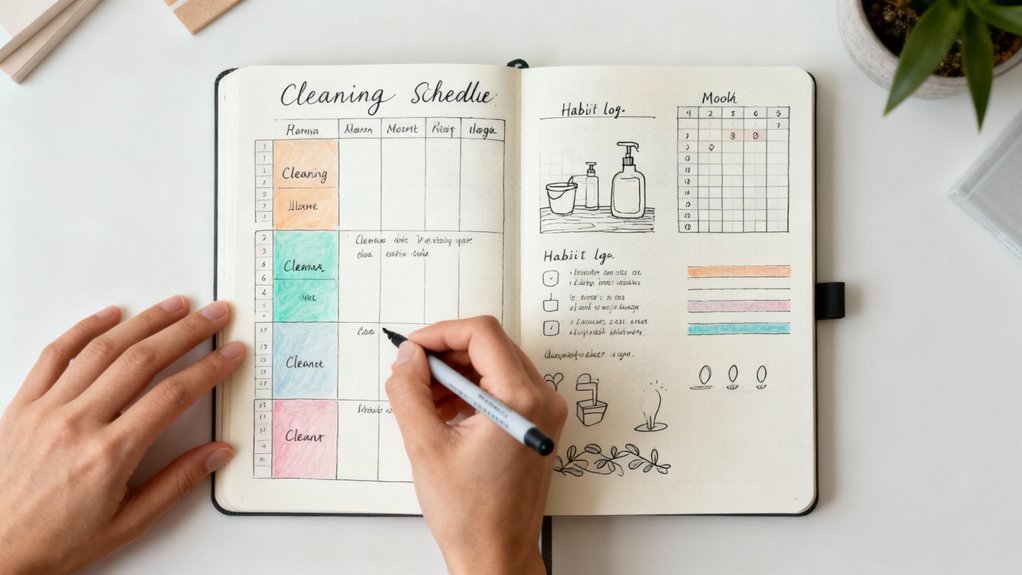
Strategic color assignments convert your bullet journal into a spatial navigation system that accelerates task identification and reduces cognitive load during cleaning sessions.
Assign distinct colors to each cleaning zone based on color significance principles. Blue represents bathrooms, green signals outdoor spaces, yellow indicates kitchens, and purple designates bedrooms. This systematic approach enables instant recognition of tasks without reading detailed descriptions.
Color-coding cleaning zones by room type creates an instant visual navigation system that eliminates the need to read task descriptions.
Implement your zone organization using these methods:
- Color-coded page tabs – Apply adhesive tabs matching each zone's designated color along your journal edges for rapid page access.
- Highlighted task blocks – Use translucent markers to shade entire task sections, creating visual boundaries between different areas.
- Colored bullet points – Replace standard bullets with zone-specific colors to distinguish locations at a glance.
Research demonstrates color-coding reduces task-switching time by 30% and improves completion rates. Your brain processes color 60,000 times faster than text, making this system neurologically efficient for maintaining cleaning momentum across multiple spaces.
Minimalist vs. Decorative Cleaning Spread Styles
Your cleaning spread's design philosophy directly impacts maintenance consistency and journal sustainability. Minimalist aesthetics prioritize function through simple layouts, monochromatic schemes, and essential text-only tracking. You'll complete these spreads in under five minutes, ensuring you won't abandon them during busy weeks. This approach works best when you're testing new cleaning routines or managing time-scarce periods.
Decorative embellishments—washi tape borders, hand-lettered headers, illustrated cleaning tools—transform spreads into motivational focal points. Research shows visual appeal increases task completion rates by 23% among creative personalities. However, elaborate designs require 20-30 minutes of setup time.
Choose your style based on honest self-assessment. If you've historically abandoned complex systems, start minimalist. You can always add decorative elements seasonally or monthly.
Hybrid approaches work too: maintain minimalist daily trackers while creating decorative monthly overview pages. Your consistency matters more than aesthetic perfection.
Frequently Asked Questions
How Do I Stay Motivated When I Fall Behind on My Cleaning Schedule?
Reset your mindset immediately—you're not behind, you're adapting.
Implement motivation strategies like the “fresh start effect” by redesigning your bullet journal spread with micro-tasks you can complete in five minutes. Partner with accountability partners who'll send daily check-ins via text or social media.
Track momentum, not perfection. Research shows small wins trigger dopamine releases that fuel continued action. Start with one room today, then innovate your system based on what actually works for your lifestyle.
Can I Share Cleaning Tasks With Roommates or Family in My Journal?
You can absolutely track shared responsibilities in your journal using creative accountability systems.
Create a collaborative spread with color-coded tasks assigned to each person, rotating weekly duties, or point-based tracking. Digital bullet journal apps enable real-time updates everyone can access.
For paper journals, establish weekly check-in meetings where you'll review completed tasks together. This structured approach changes cleaning accountability into a transparent, gamified system that encourages consistent participation and reduces household tension around chores.
What Do I Do if My Cleaning Routine Isn't Working Anymore?
Redesign your spread immediately when you notice decreased cleaning motivation or inefficiency. Track what's failing—unrealistic time blocks, wrong task frequencies, or life changes—then test routine adjustments for two weeks.
Experiment with different scheduling methods: time-blocking, habit stacking, or flexible weekly goals. Consider rotating quarterly themes or gamification elements to maintain engagement.
Your bullet journal's adaptability is its strength, so iterate fearlessly. Document what works to build your personalized, evidence-based cleaning system that evolves with your lifestyle.
How Do I Balance Cleaning Schedules With My Unpredictable Work Schedule?
Think of your cleaning plan as a river, not a railroad—it needs to flow around obstacles.
You'll thrive with flexible cleaning blocks rather than fixed times. Identify your priority tasks (kitchen, bathroom) and assign them to “anchor days” you're typically home.
Use your bullet journal's habit tracker to mark completions whenever they happen.
Research shows adaptable systems outperform rigid schedules for shift workers, creating sustainable routines that bend without breaking.
Should I Create a New Cleaning Spread if I Move Homes?
Yes, you'll definitely want to create a fresh cleaning spread when relocating. Your new space has different layouts, storage systems, and maintenance needs.
Start with a moving checklist to track deep-cleaning tasks for both locations, then design your new spread based on actual home organization requirements you discover during the first week.
This evidence-based approach guarantees you're building systems around your space's unique characteristics rather than forcing outdated routines into new environments.
Conclusion
Picture your bullet journal as a cleaning command center, where vibrant trackers and strategic layouts convert mundane tasks into accomplished checkmarks. You've now got the blueprint—from daily sweeps to seasonal overhauls—to maintain a spotless sanctuary. Grab your favorite pens and start mapping your first spread today. As you consistently track and refine your routine, you'll watch dust bunnies retreat and clutter dissolve, leaving behind organized spaces that breathe fresh purpose into your home.

